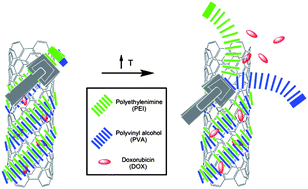

A thermosensitive drug delivery system based on polymer-gated carbon nanotubes (CNTs) that are loaded with the anticancer drug doxorubicin (DOX) is herein reported. The development of carbon nanotubes for various biomedical applications is the research focus of many research groups and holds great promise. The major drawback of these materials is the toxicity that is associated with conjugated carbon systems. Functionalization of CNTs with polymers has proved very successful in lowering the toxicity and improving the pharmacokinetic profile. In this work, CNTs are coated with polyethylenimine (PEI) and polyvinyl alcohol (PVA) via the “zipper effect” that provides both support and control over drug release. PEI/PVA provides excellent support to increase DOX loading on the nanocarrier. The system is controlled by changes in temperature due to the complexation (low temperature) and decomplexation (high temperature) of PEI and PVA via hydrogen bonding. The release of DOX was tested in three cell lines (Lung fibroblast (LF), Breast Adenocarcinoma (BA), and HeLa). It was further tested in primary cell lines (Human Dermal Fibroblast adult (HDFa) and Human Dermal Fibroblast neonatal (HDFn)). When the bonds between PEI and PVA are decomplexed at high temperature (≥40 °C), drug release was observed as verified by fluorescence microscopy. There was no drug release at room temperature (25 °C) and a slow release at normal body temperature (37 °C). This system represents a promising method for incorporating stimuli triggered polymer-gated CNTs in future controlled release applications.
